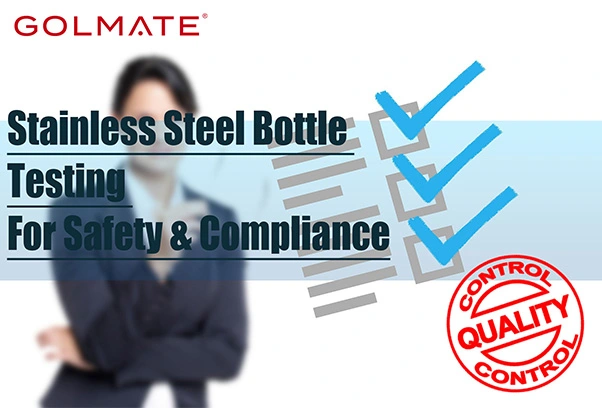WHAT ARE YOU LOOKING FOR?

Ensuring accurate testing of stainless steel bottles is crucial for importers, considering their classification as food contact material products (FCMs). These bottles are highly sought-after and frequently inquired about. In this article, we will outline the necessary compliance testing procedures that must be conducted to successfully bring stainless steel products into the market, while prioritizing user safety.
Stainless steel bottles have become more and more popular in recent years due to their environmental friendliness and health benefits.
Made from high-quality food-grade materials, stainless steel bottles ensure that they are safe to use and free from any harmful chemicals. They're also more eco-friendly than other types of water bottles. Stainless steel is completely recyclable and it doesn't leach chemicals into your water like plastic does. This makes them ideal for people who are concerned about their impact on the environment. If you are looking for stainless steel water bottle bulk, you can contact us for more information.
Countries and Regions | Food Grade Tests |
Germany | LFGB |
France | DGCCRF |
North America | Cali Pro 65/FDA |
Europe | LFGB/RACH/EN12546 |
*Golmate guarantees the use of 100% new materials and does not use any recycled materials | |
Capacity (in ml) | Flasks | Carafes | Food-flasks | Airpots |
0 to 200 | 60 | |||
201 to 400 | 65 | 60 | 50 | 50 |
401 to 600 | 70 | 65 | 60 | 60 |
601 to 800 | 75 | 70 | 62 | 60 |
801 to 1200 | 78 | 75 | 66 | 70 |
>1200 | 80 | 78 | 70 | 75 |
EN1254-6 Minimum temperatures (C) for vacuum insulated containers | ||||
To comply with using standards, stainless steel water bottles should be approved by related certifications for different regions.
In the Europe market, products should meet the standards of LFGB, REACH, and EN123546. EN123546 includes function tests of handle-bearing capability, sealing, tilt, insulation, and so on. REACH stipulates that finished products should avoid and enable the chemical composition listed by the EU. Although France has its standard for the local market-DGCCRF, which is strict for silicone tests.
For North America, products should pass Cali Pro 65 (Exclusive for California) or FDA(U.S. Food and Drug Administration) standards.
How does the production process work at Golmate once testing has begun? Let's break down the process:
Visual Inspection: During the production process, workers can inspect the bottles visually to check for any defects such as dents, scratches, or other imperfections.
Pressure Testing: Stainless steel bottles are often designed to withstand high pressures, so pressure testing is a crucial step in ensuring their durability. The bottles can be filled with water and pressurized to a certain level to make sure they do not leak or deform under pressure.
Leak Testing: Another way to test the integrity of the bottle is to subject it to leak testing. This involves filling the bottle with water and checking for leaks by either submerging it in water or applying pressure to specific points.
Drop Testing: Simulate potential impact during transportation and ensure the bottle can withstand it without damage.
Chemical Analysis: Ensure the material of the bottle is free from harmful contaminants like lead, chromium or nickel.
These tests can be conducted at different stages of production, including after molding, after polishing, and after assembly. Independent third-party testing can also be performed to verify compliance with safety standards and regulations.
The more you learn about drinking water container testing, the easier it will be to make smart, safe purchases. Golmate drinkware has a rigorous testing process for our stainless steel bottles. They follow strict standards to ensure the safety and quality of their products. Additionally, we use high-quality materials and advanced manufacturing processes to produce durable and long-lasting bottles. Overall, Golmate's commitment to testing and quality control ensures that customers can trust their stainless steel bottles to be safe and reliable for everyday use.